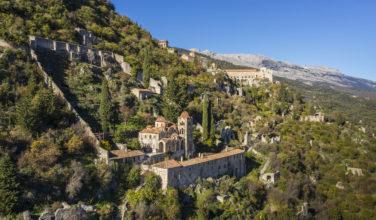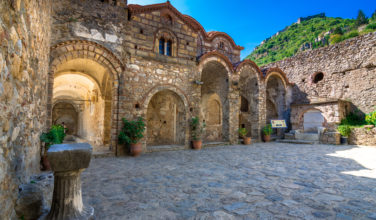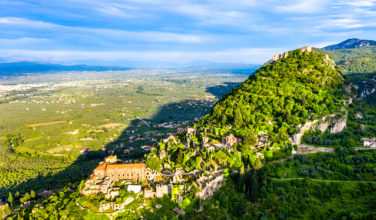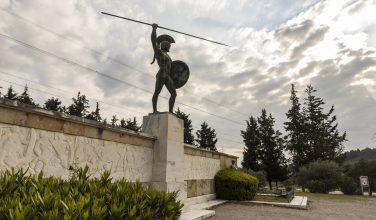Sparta is a town in Laconcia, Greece. It is the same site as the ancient site of Sparta. The town was constructed using a well-thought out design that 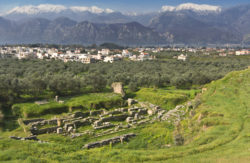 makes it one of the few places in Greece that has squares, parks, and wide streets. The geography around Sparta is flat and mountainous. The region is rich in olive trees. Sparta, along with Levos and Crete, is one of the best producers of olive oil in Greece.
makes it one of the few places in Greece that has squares, parks, and wide streets. The geography around Sparta is flat and mountainous. The region is rich in olive trees. Sparta, along with Levos and Crete, is one of the best producers of olive oil in Greece.
In ancient Greece, Sparta was a prominent city-state. Sparta would rise to become a dominant military power around 650 BC. During the Greco-Persian, it would be a leading force in the unified Greek military. From 431 – 404 BC, Sparta was an enemy of Athens during the Peloponnesian War. Sparta would emerge victorious, but many lives were lost. It was their defeat in 371 BC by Thebes during the Battle of Leuctra that would end Sparta’s prominent role in Greece.
Once Sparta began to decline, it would become prey to emerging power in northern Greece. Later, Romans would conquer Sparta, who would soon follow the fate of the rest of Greece. During Byzantine times, the development of Mystras would pick up speed and Sparta’s would decline. During the middle of the 19th century, King Otto decided to restore the town with a modern plan.
In ancient Sparta, education for boys was strict. They would leave their families at age 7 to live in dormitories. The boys would be divided into groups with the strongest becoming group leaders. The boys slept on floor, ate bad food, and wore light clothes even during winter. The intent was to make them stronger and help them overcome all obstacles. Spartan girls lived with their families and would learn military exercises in addition to learning how to run the household, and spin and weave.
Administrative Region for Sparta, Greece
Peloponnese
Area of Sparta, Greece
Municipality: 1,181.8 km2 (456.3 sq mi)
Municipal Unit: 84.5 km2 (32.6 sq mi)
Population of Sparta, Greece
Municipality: 35,259
Municipal Unit: 19,854
Top Attractions in Sparta, Greece
The Acropolis of Sparta – The first excavations here took place in 1910. The most significant monuments at the site include: the Temple of Athena Chalkioikos, the Ancient Theatre of Sparta, and the Circular Building of Unknown Destination. There are also remains of merchant stalls.
The Sanctuary of Artemis Orthia – Located near the ancient town of Limnon. This is a sanctuary of the Spartan cult, associated with the education of young Spartans. There are three distinguishable sections.
Archaeological Museum of Sparta – The museum contains a number of halls with various exhibitions. There are sculptures from the Roman period as well as portraits and parts of mosaic floors. Also featured are findings from the pre-historic period.
The Sanctuary of Apollo Amyklaios – On this site an important Spartan feast took place, the Hyacinth. The feast took place annually to honor Hyakinthos, a friend of Apollo who was a god of vegetation. Located on the Hill of Agia Kyriaki in Amykles.
The Hellenic Bridge – An important archaeological monument, this bridge is thought to be the most ancient, still operating bridge in Europe. It was built by the Spartans in the 1st century BC. The bridge is located in Xirokambi.
Museum of Ecclesiastical Art – This museum is housed on the second floor of the Metropolitan building. It consists of a rich collection of religious art from the last five centuries. There are also portable icons, gold embroidery, and illustrated manuscript codes.
Pellana – Pellana is an archaeological site. It consists of The Cemetery of Vaulted Chamber Tombs, which dates back to Mycenaean times. There is also the Acropolis of Pellana, where there are remnants of Hellenistic walls.
Museum of the Olive and Greek Olive Oil – Showcases the culture and technology around olive oil production. This industry has a long history in Greece. The museum is located in Lakonia.
Museum of Modern Sparta – This museum is housed in a Neoclassical building. It serves as a “guardian” of cultural goods. The purpose of this museum is to collect, safeguard, and promote everything associated with the city, especially for new and future generations of Spartans.
Sainopouleio Amphitheatre – Located in a park of the same name. There is an orchestra that has seating for at least 1500. The area is well-maintained, there are facilities and the nature around is beautiful.


